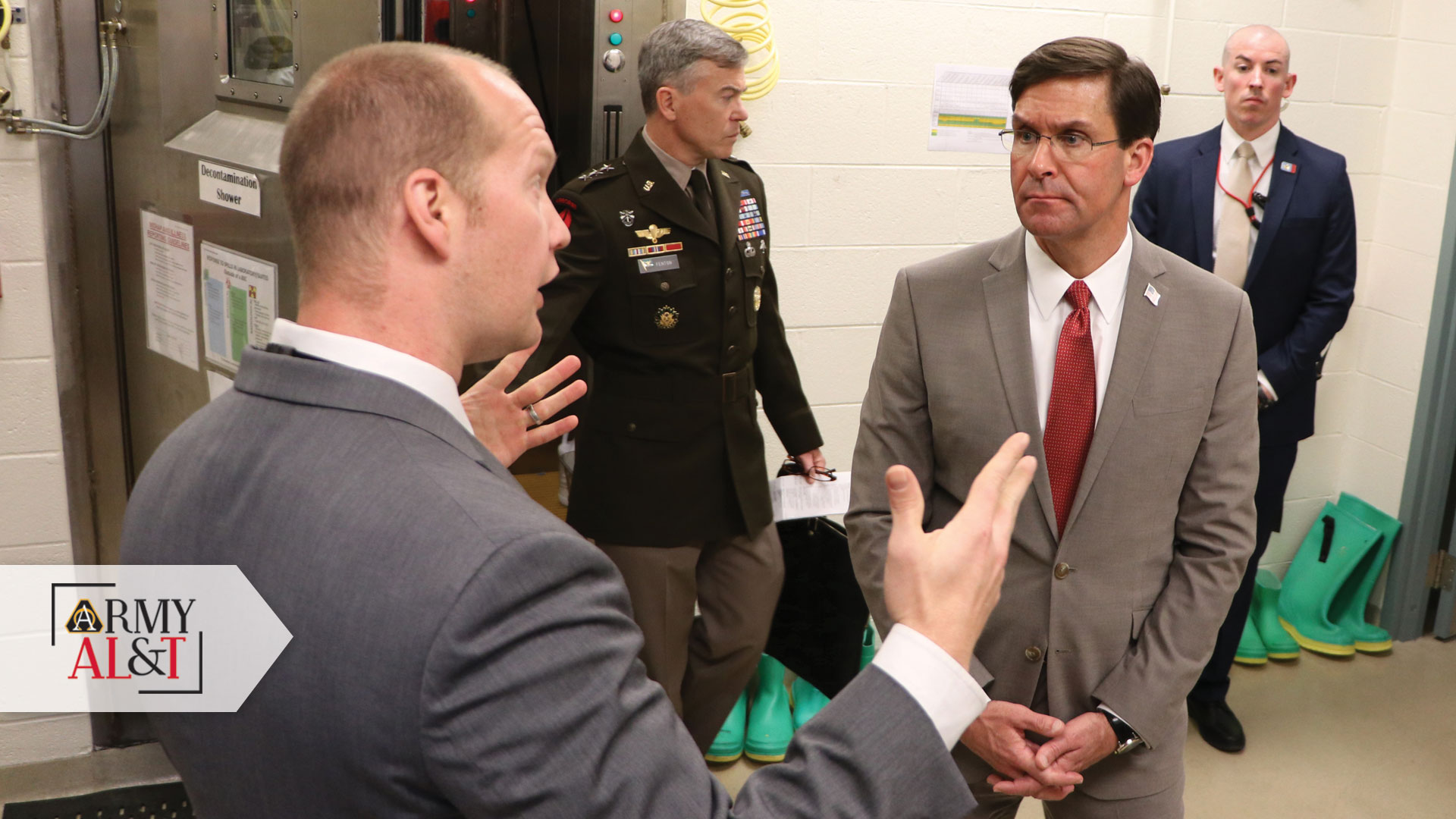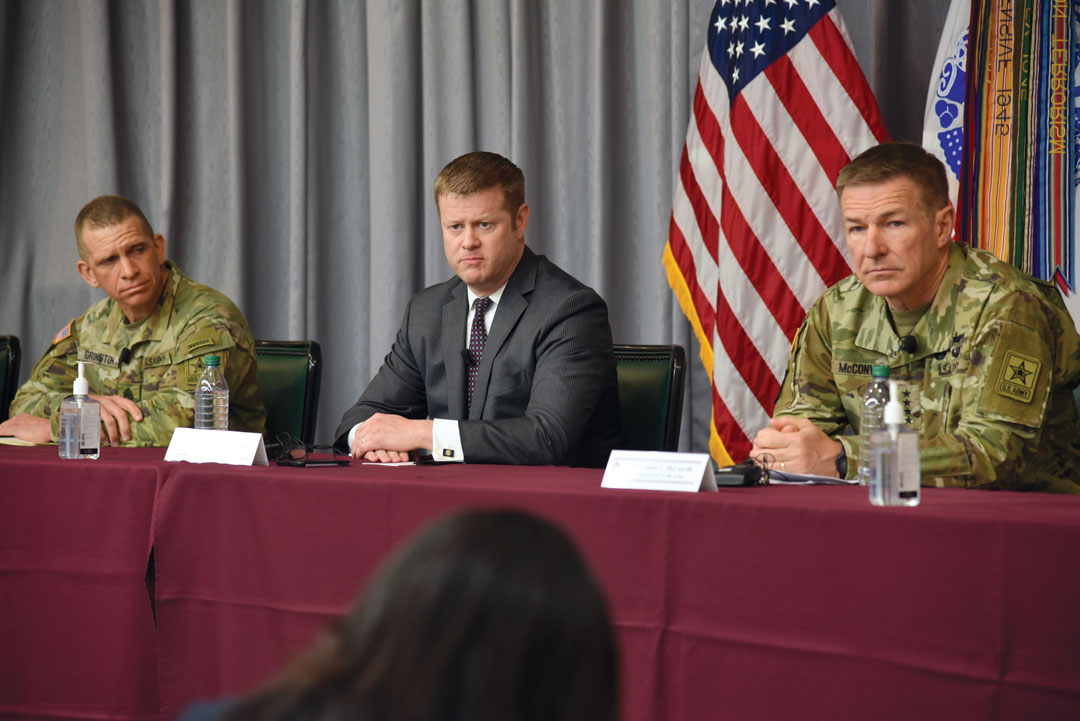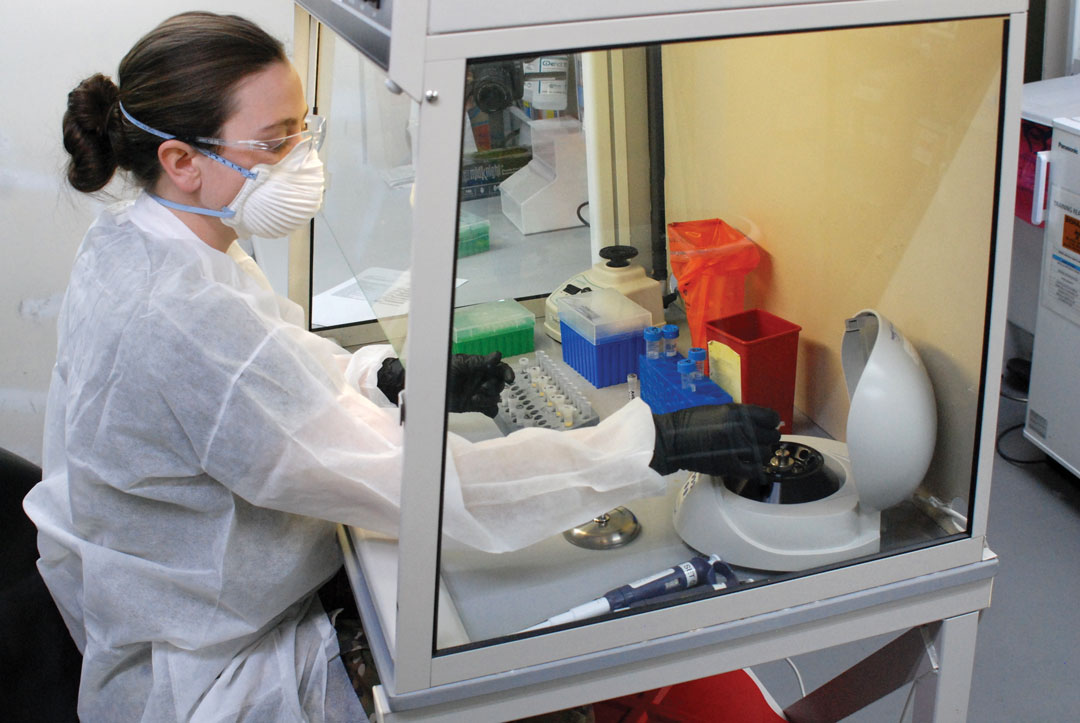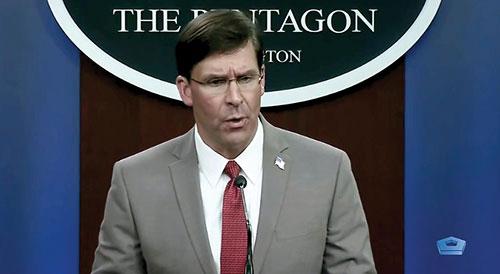
BRIEFING THE BOSS: Secretary of Defense Mark T. Esper speaks with biological safety officer David Harbourt during a tour of USAMRIID at Fort Detrick in March. (Photo by John W. Braun Jr., USAMRIID)
CENTER STAGE ON COVID-19
USAMRDC a key contributor to Army, DOD pandemic response plan.
by Ramin A. Khalili
Following a visit to the U.S. Army Medical Research and Development Command (USAMRDC) at Fort Detrick, Maryland, on March 17, Secretary of Defense Mark T. Esper spoke to reporters at the Pentagon regarding the Army’s role in combating the COVID-19 pandemic. “The Army’s work on a vaccine is one of the many ways the Department of Defense is supporting President Trump’s ‘whole-of-government’ approach to fight the virus and substantially slow its spread,” said Esper, launching a coordinated effort to position USAMRDC as one of the key contributors to the federal response to COVID-19.
Esper’s visit was the centerpiece of a busy March at USAMRDC, which saw similar visits from Secretary of the Army Ryan D. McCarthy, Army Chief of Staff Gen. James C. McConville and Sergeant Major of the Army Michael A. Grinston in the same week. “The chance to talk to the doctors face to face was really helpful to me in understanding what they’re doing,” Esper said of his visit. “They’ve been very successful in the past, whether it’s dealing with Ebola or Zika, [and] they have incredible capabilities.”
Recent successes in combating the Ebola virus underline the command’s robust track record in mobilizing infrastructure and delivering results when faced with emerging infectious disease threats. In late 2019, after a more than 15-year journey and following initial testing and several preclinical trials performed at USAMRDC’s U.S. Army Medical Research Institute of Infectious Diseases (USAMRIID), the U.S. Food and Drug Administration (FDA) approved the first vaccine to prevent Ebola, marketed under the trade name Ervebo.
READY TO RESPOND
This record of success ensures that USAMRIID is well poised to support the COVID-19 pandemic response. Scientists at USAMRIID received a sample of SARS-CoV-2, the virus that causes COVID-19, from the U.S. Centers for Disease Control and Prevention (CDC) in February. The institute is developing models that represent the course of the disease in humans. These models will be used to evaluate vaccines, diagnostics and therapeutics developed by USAMRIID and its partners.
In addition, USAMRIID has the capability to perform screening of small molecules for drug development, and is screening thousands of drugs simultaneously to look for activity against the current coronavirus manifestation. USAMRIID leaders and virus experts are also part of a COVID-19 task force charged with providing updates to senior Army leaders on a daily basis.

MEET THE PRESS: Secretary of the Army Ryan D. McCarthy, center, listens to a question from a reporter during a news conference at USAMRIID in March. (Photo by Erin Bolling, USAMRDC Public Affairs)
During his visit to USAMRIID, McCarthy notably referenced USAMRDC’s three key lines of effort in the battle against COVID-19—prevention, detection and treatment—and their enduring importance in combating the virus. In addition, McCarthy mentioned the development of several vaccine candidates within USAMRDC and across the private and public sectors. “We’re learning every day,” he said during a post-tour meeting with reporters at USAMRIID. “We are getting smarter with regard to this problem every day.”
In his remarks, McConville noted the impact of the pandemic on recruiting efforts, stating that the Army has already begun testing both new and potential recruits for the virus. McConville further confirmed that additional testing of enlisted Soldiers in the following one- to two-month period would help determine the overall risk to the force, at which point Army leaders would be able to determine the impact of COVID-19 on the overall mission. Showing his gratitude to the Army researchers, physicians and scientists working to develop medical countermeasures against COVID-19, McConville said, “We are proud of them and we support what they’re doing.”

CULTURE PREP: USAMRIID scientists prepare cultures for a testing exercise at Fort Detrick in March. (Photo by Ramin A. Khalili, USAMRDC Public Affairs)
FAR-RANGING DEVELOPMENTS
As for current research projects taking place at USAMRDC, Brig. Gen. Michael J. Talley, commanding general of USAMRDC and Fort Detrick, was quick to assure the public that those efforts will continue unabated. “Your health and safety remains our top priority,” said Talley during a livestreamed town tall with staff and the community on March 16. “I am committed to doing everything to keep you healthy and to keep us mission ready.”
USAMRDC’s efforts extend to the command’s other laboratories as well. The Walter Reed Army Institute of Research (WRAIR) is hard at work on the COVID-19 response, having produced prototype vaccines from which it will ultimately select one, based on testing, to move forward into initial clinical testing in humans. WRAIR is also publishing the highest-quality images of the COVID-19 virus spike—the spindle that protrudes from the virus itself, and by which the virus attaches itself to the lungs—which are serving as a road map for vaccine and therapy development. By better understanding that specific portion of the virus through images like those WRAIR has developed, scientists can better determine how to prevent it from infecting people.
The command’s partnerships with industry and academia are bolstering efforts during this time. WRAIR, for example, is actively working with the National Institutes of Health and industry partners to evaluate promising vaccines in various stages of development. WRAIR is also collaborating with the Army Public Health Center on a pilot project that will include blood tests for COVID-19 exposure in Army recruit training, to reduce the threat of exposure and impact on recruits while in training.

TARGET COVID19: Spc. Taylor Wolik, a medical laboratory specialist with the 1st Area Medical Laboratory, performs a diagnostic assay at USAMRIID in March. In the battle against COVID-19, detection is one of three major lines of effort, the other two being prevention and treatment. (Photo by William F. Discher, USAMRMC)
USAMRDC’s U.S. Army Medical Materiel Development Activity (USAMMDA) recently entered into a cooperative research and development agreement with Gilead Sciences Inc. to use the investigational drug remdesivir to treat active-duty Army personnel exposed to COVID-19. The drug was shipped to 13 military treatment facilities. An investigational drug is a substance that has been tested in the laboratory and has been approved by the FDA for testing in people.
Additionally, USAMMDA contributed medical materiel expertise to the virus response effort following the late March deployment announcement of a handful of hospital centers and combat support hospitals. The USAMMDA Warfighter Deployed Medical Systems (WDMS) team has been tasked with filling shortages for the deploying units by surveying current equipment stock, cutting stock transfer orders to facilitate delivery of key materials and coordinating with a slew of other agencies, including U.S. Army Sustainment Command and U.S. Army Materiel Command, to ensure that
deploying units have the equipment required to perform their missions. “We have been working on ensuring any shortages in equipment for the mission are top priority to fulfill,” says Lindsay Longobardi, deputy project manager for WDMS. “Our team has exercised multiple contracting actions to ensure critical care medical devices [are] shipped to the units [and] on the ground in as little as 24 hours.”
Several other Army laboratories are lending their expertise in the fight against COVID-19. The U.S. Army Aeromedical Research Laboratory performed a rapid-response evaluation of aircrew performance while wearing an N-95 mask and various models of cloth masks to assess the effects of wearing the mask for speech intelligibility, usability, workload, situational awareness and comfort, to determine what masks are compatible with safe flight. According to the CDC, the N-95 mask filters out at least 95 percent of airborne particles—including both large and small particles—when properly fitted and donned, making it a higher, more professional-grade mask. The lab is also testing several patient isolation units to possibly transport COVID-19 patients on U.S. Army and Army National Guard medical evacuation aircraft.
At the U.S. Army Institute of Surgical Research, scientists are using results from previous hemorrhagic shock studies to identify parts of the blood that confer immunity in patients who have recovered from COVID-19 infections. This is known as “convalescent plasma,” and the technique has the potential to treat COVID-19.

BACK AT THE PENTAGON: Secretary of Defense Mark T. Esper delivers remarks at the Pentagon following a visit in March to USAMRDC at Fort Detrick. (DOD photo)
For USAMRIID and WRAIR, the focus continues to be a vaccine. According to Esper, it will likely take USAMRDC-affiliated labs between 12 and 18 months to develop a functional COVID-19 vaccine, a time frame echoed by several other federal agencies and experts. However, to spur cooperation with private industry partners, Esper has touted USAMRDC’s capabilities in testing and evaluating vaccines developed by other entities. Efforts in the lab will, of course, be complemented by pandemic response initiatives in local hospitals and communities across the country, as federal and DOD support continues to expand.
“If we can dramatically reduce the spread of the virus,” said Esper, “then together we can help restore public health and the economy and hasten a return to our normal way of life.”
For continuous updates on the USAMRDC response to COVID-19, go to https://mrdc.amedd.army.mil/index.cfm/resources/covid-19. For more information about the USAMRDC, go to https://mrdc.amedd.army.mil/.
RAMIN A. KHALILI is a writer with the USAMRDC Public Affairs Office. Before assuming his current role, he spent several years as the knowledge manager for the USAMRDC’s Combat Casualty Care Research Program. During his previous work as a broadcast journalist, he earned an Associated Press Award for his work in Phoenix, before serving as chief NASA correspondent for CBS in Orlando, Florida. He holds a B.A. in communications from Penn State University.
Read the full article in the Summer 2020 issue of Army AL&T magazine.
Subscribe to Army AL&T News – the premier online news source for the Army Acquisition Workforce. ![]() Subscribe
Subscribe







